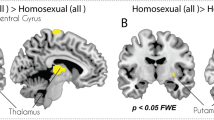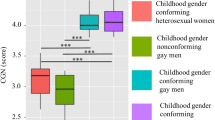Abstract
The results of several studies have shown that homosexual men have an increased prevalence of non-right-handedness and atypical patterns of hemispheric functional asymmetry. Non-right-handedness in men has been associated with increased size of the corpus callosum (CC), particularly of the isthmus, which is the posterior region of the callosal body connecting parietotemporal cortical regions. We hypothesized that isthmal area would be greater in homosexual men, even among right handers. Twelve homosexual and ten heterosexual healthy young men, all consistently right-handed, underwent a research-designed magnetic resonance imaging scan. We found that the isthmal area was larger in the homosexual group, adding to the body of findings of structural brain differences between homosexual and heterosexual men. This result suggests that right-handed homosexual men have less marked functional asymmetry compared to right-handed heterosexual men. The results also indicate that callosal anatomy and laterality for motoric functions are dissociated in homosexual men. A logistic regression analysis to predict sexual orientation category correctly classified 21 of the 22 men (96% correct classification) based on area of the callosal isthmus, a left-hand performance measure, water level test score, and a measure of abstraction ability. Our findings indicate that neuroanatomical structure and cognition are associated with sexual orientation in men and support the hypothesis of a neurobiological basis in the origin of sexual orientation.

Similar content being viewed by others
References
Allen, L. S., & Gorski, R. A. (1992). Sexual orientation and the size of the anterior commissure in the human brain. Proceedings of the National Academy of Sciences USA, 89, 7199–7202.
Annett, M. (1967). The binomial distribution of right, mixed and left handedness. Quarterly Journal of Experimental Psychology, 19, 327–333.
Blanchard, R. (2004). Quantitative and theoretical analyses of the relation between older brothers and homosexuality in men. Journal of Theoretical Biology, 230, 173–187.
Bogaert, A. F., & Blanchard, R. (1996). Handedness in homosexual and heterosexual men in the Kinsey interview data. Archives of Sexual Behavior, 25, 373–378.
Byne, W., Tobet, S., Mattiace, L. A., Lasco, M. S., Kemether, E., Edgar, M. A., et al. (2001). The interstitial nuclei of the human anterior hypothalamus: An investigation of variation with sex, sexual orientation, and HIV status. Hormones and Behavior, 40, 86–92.
Clarke, J. M., Lufkin, R. B., & Zaidel, E. (1993). Corpus callosum morphometry and dichotic listening performance: Individual differences in functional interhemispheric inhibition? Neuropsychologia, 31, 547–557.
Cowell, P. E., Kertesz, A., & Denenberg, V. H. (1993). Multiple dimensions of handedness and the human corpus callosum. Neurology, 43, 2353–2357.
Ekstrom, R. B., French, J. W., Harman, H. H., & Dermen, D. (1976). Kit of factor-referenced cognitive tests. Princeton, NJ: Educational Testing Service.
Gladue, B. A., Beatty, W. W., Larson, J., & Staton, R. D. (1990). Sexual orientation and spatial ability in men and women. Psychobiology, 18, 101–108.
Hamer, D. H., Hu, S., Magnuson, V. L., Hu, N., & Pattatucci, A. M. (1993). A linkage between DNA markers on the X chromosome and male sexual orientation. Science, 261, 321–327.
Hines, M., Brook, C., & Conway, G. S. (2004). Androgen and psychosexual development: Core gender identity, sexual orientation and recalled childhood gender role behavior in women and men with congenital adrenal hyperplasia (CAH). Journal of Sex Research, 41, 75–81.
Hofer, S., & Frahm, J. (2006). Topography of the human corpus callosum revisited: Comprehensive fiber tractography using diffusion tensor magnetic resonance imaging. Neuroimage, 32, 989–994.
Hulshoff Pol, H. E., Schnack, H. G., Posthuma, D., Mandl, R. C. W., Baaré, W. F., van Oel, C., et al. (2006). Genetic contributions to human brain morphology and intelligence. Journal of Neuroscience, 26, 10235–10242.
Kinsey, A. C., Pomery, W. B., & Martin, C. E. (1948). Sexual behavior in the human male. Philadelphia, PA: Saunders.
Kolb, B., & Whishaw, I. Q. (2003). Fundamentals of human neuropsychology (5th ed.). New York: W. H. Freeman.
Lalumiére, M. L., Blanchard, R., & Zucker, K. J. (2000). Sexual orientation and handedness in men and women: A meta-analysis. Psychological Bulletin, 126, 575–592.
Lasco, M. S., Jordan, T. J., Edgar, M. A., Petito, C. K., & Byne, W. (2002). A lack of dimorphism of sex or sexual orientation in the human anterior commissure. Brain Research, 936, 95–98.
LeVay, S. (1991). A difference in hypothalamic structure between heterosexual and homosexual men. Science, 253, 1034–1037.
Lindesay, J. (1987). Laterality shift in homosexual men. Neuropsychologia, 25, 965–969.
Luders, E., Rex, D. E., Narr, K. L., Woods, R. P., Jancke, L., Thompson, P. M., et al. (2003). Relationships between sulcal asymmetries and corpus callosum size: Gender and handedness effects. Cerebral Cortex, 13, 1084–1093.
McCormick, C. M., & Witelson, S. F. (1991). A cognitive profile of homosexual men compared to heterosexual men and women. Psychoneuroendocrinology, 16, 459–473.
McCormick, C. M., & Witelson, S. F. (1994). Functional cerebral asymmetry and sexual orientation in men and women. Behavioral Neuroscience, 108, 525–531.
McCormick, C. M., Witelson, S. F., & Kingstone, E. (1990). Left-handedness in homosexual men and women: Neuroendocrine implications. Psychoneuroendocrinology, 15, 69–76.
McFadden, D., & Pasanen, E. G. (1998). Comparison of the auditory systems of heterosexuals and homosexuals: Click-evoked otoacoustic emissions. Proceedings of the National Academy of Sciences USA, 95, 2709–2713.
Morton, B. E., & Rafto, S. E. (2006). Corpus callosum size is linked to dichotic deafness and hemisphericity, not sex or handedness. Brain and Cognition, 62, 1–8.
Mustanski, B. S., Chivers, M. L., & Bailey, J. M. (2002). A critical review of recent biological research on human sexual orientation. Annual Review of Sex Research, 13, 89–140.
Peng, C.-Y. J., So, T.-S. H., Stage, F. K., & St. John, E. P. (2002). The use and interpretation of logistic regression in higher education journals. Research in Higher Education, 43, 259–293.
Pillard, R. C., & Bailey, J. M. (1998). Human sexual orientation has a heritable component. Human Biology, 70, 347–365.
Rahman, Q., & Wilson, G. D. (2003). Large sexual-orientation-related differences in performance on mental rotation and judgment of line orientation tasks. Neuropsychology, 17, 25–31.
Rice, G., Anderson, C., Risch, N., & Ebers, G. (1999). Male homosexuality: Absence of linkage to microsatellite markers at Xq28. Science, 284, 665–667.
Sanders, G., & Ross-Field, L. (1986). Sexual orientation and visuo-spatial ability. Brain and Cognition, 5, 280–290.
Sanders, G., & Wright, M. (1997). Sexual orientation differences in cerebral asymmetry and in the performance of sexually dimorphic cognitive and motor tasks. Archives of Sexual Behavior, 26, 463–480.
Savic, I., Berglund, H., & Lindstrom, P. (2005). Brain responses to putative pheromones in homosexual men. Proceedings of the National Academy of Sciences USA, 102, 7356–7361.
Scamvougeras, A., Kigar, D. L., Jones, D., Weinberger, D. R., & Witelson, S. F. (2003). Size of the human corpus callosum is genetically determined: An MRI study in mono and dizygotic twins. Neuroscience Letters, 338, 91–94.
Shipley, W. C. (1940). A self-administering scale for measuring intellectual impairment and deterioration. Journal of Psychology, 9, 371–377.
Steinmetz, H., Jancke, L., Kleinschmidt, A., Schlaug, G., Volkmann, J., & Huang, Y. (1992). Sex but no hand difference in the isthmus of the corpus callosum. Neurology, 42, 749–752.
Swaab, D. F., & Hofman, M. A. (1990). An enlarged suprachiasmatic nucleus in homosexual men. Brain Research, 537, 141–148.
Tapley, S. M., & Bryden, M. P. (1985). A group test for the assessment of performance between the hands. Neuropsychologia, 23, 215–221.
Thomas, H., Jamison, W., & Hummel, D. D. (1973). Observation is insufficient for discovering that the surface of still water is invariantly horizontal. Science, 181, 173–174.
Thurstone, L. L., & Thurstone, T. G. (1962). Primary mental abilities for grades 9–12. Chicago, IL: Science Research Associates.
Tuncer, M. C., Hatipoglu, E. S., & Ozates, M. (2005). Sexual dimorphism and handedness in the human corpus callosum based on magnetic resonance imaging. Surgical and Radiologic Anatomy, 27, 254–259.
van Anders, S. M., & Hampson, E. (2005). Testing the prenatal androgen hypothesis: Measuring digit ratios, sexual orientation, and spatial abilities in adults. Hormones and Behavior, 47, 92–98.
Wegesin, D. J. (1998). Event-related potentials in homosexual and heterosexual men and women: Sex-dimorphic patterns in verbal asymmetries and mental rotation. Brain and Cognition, 36, 73–92.
Westerhausen, R., Walter, C., Kreuder, F., Wittling, R. A., Schweiger, E., & Wittling, W. (2003). The influence of handedness and gender on the microstructure of the human corpus callosum: A diffusion-tensor magnetic resonance imaging study. Neuroscience Letters, 351, 99–102.
Witelson, S. F. (1989). Hand and sex differences in the isthmus and genu of the human corpus callosum: A postmortem morphological study. Brain, 112, 799–835.
Witelson, S. F., & Nowakowski, R. S. (1991). Left out axons make men right: A hypothesis for the origin of handedness and functional asymmetry. Neuropsychologia, 29, 327–333.
Yokota, Y., Kawamura, Y., & Kameya, Y. (2005). Callosal shapes at the midsagittal plane: MRI differences of normal males, normal females, and GID. In Proceedings of the 2005 IEEE engineering in medicine and biology 27th annual conference, Shangai, China, pp. 3055–3058.
Zucker, K. J., & Bradley, S. J. (1995). Gender identity disorder and psychosexual problems in children and adolescents. New York: Guilford Press.
Acknowledgments
This work was supported by research grants NIH NS18954 and MRC 10610 to S.F.W. A.S. held an Ontario Mental Health Foundation fellowship and D.M.K. held an Ontario Graduate Scholarship, while at McMaster University. We thank Dr. Charles Goldsmith, Department of Epidemiology and Biostatistics, McMaster University, for statistical advice.
Author information
Authors and Affiliations
Corresponding author
Rights and permissions
About this article
Cite this article
Witelson, S.F., Kigar, D.L., Scamvougeras, A. et al. Corpus Callosum Anatomy in Right-Handed Homosexual and Heterosexual Men. Arch Sex Behav 37, 857–863 (2008). https://doi.org/10.1007/s10508-007-9276-y
Received:
Revised:
Accepted:
Published:
Issue Date:
DOI: https://doi.org/10.1007/s10508-007-9276-y




